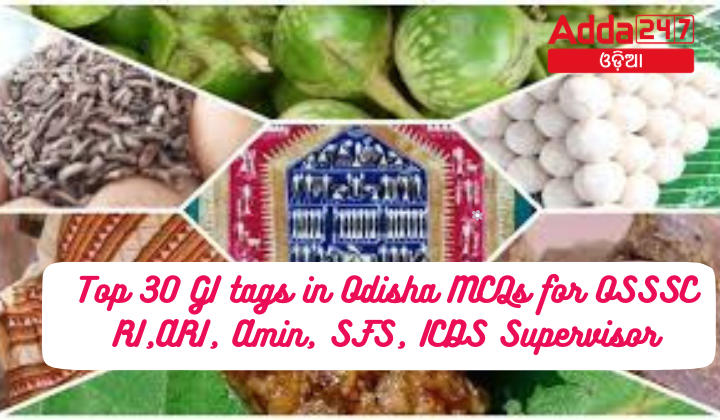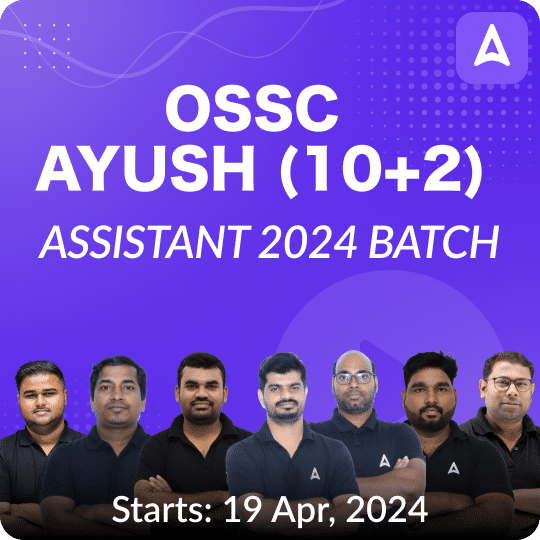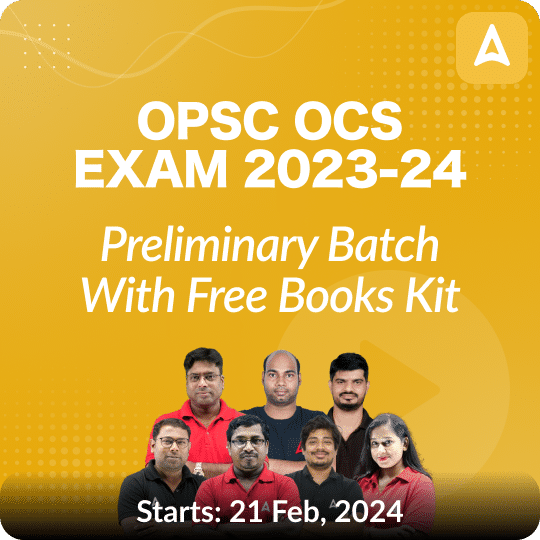Top 30 GI tags in Odisha MCQs for OSSSC RI,ARI, Amin, SFS, ICDS Supervisor
- Which state recently received a GI tag for “Koraput Kala Jeera Rice”?
a) Odisha
b) West Bengal
c) Karnataka
d) Assam
Answer: a) Odisha - What category does “Orissa Ikat” belong to, which recently received a GI tag?
a) Handicraft
b) Handloom
c) Cuisine
d) Agricultural product
Answer: a) Handicraft - “Similipal Kai chutney” is a traditional delicacy from which district of Odisha?
a) Kalahandi
b) Rayagada
c) Mayurbhanj
d) Nayagarh
Answer: c) Mayurbhanj - Which tribal community is associated with the traditional Lanjia Saura paintings?
a) Dongria Kondh
b) Lanjia Saura
c) Nayagarh Kantaimundi
d) Gajapati
Answer: b) Lanjia Saura - The “Kantaimundi Brinjal” is primarily grown in which district of Odisha?
a) Rayagada
b) Koraput
c) Nayagarh
d) Mayurbhanj
Answer: c) Nayagarh - What is the primary ingredient used to make “Odisha Khajuri Guda”?
a) Date palm
b) Coconut
c) Jaggery
d) Milk
Answer: a) Date palm - “Dhenkanal Magji” is a dessert originating from which district of Odisha?
a) Gajapati
b) Dhenkanal
c) Rayagada
d) Mayurbhanj
Answer: b) Dhenkanal - Which tribal community is known for crafting the “Kapdaganda shawl” in Odisha?
a) Dongria Kondh
b) Lanjia Saura
c) Nayagarh Kantaimundi
d) Similipal Kai
Answer: a) Dongria Kondh - What is the significance of the yellow thread used in the “Kapdaganda shawl”?
a) Represents mountains
b) Symbolizes blood
c) Signifies calm and pleasure
d) Represents the Sun
Answer: c) Signifies calm and pleasure - Which region of Odisha is known for its “Off-white coarse cotton” used in the “Kapdaganda shawl”?
a) Nayagarh
b) Kalahandi
c) Rayagada
d) Dhenkanal
Answer: c) Rayagada - What is the primary characteristic of “Koraput Kala Jeera Rice”?
a) Small size
b) Red color
c) Aroma similar to cumin seeds
d) High starch content
Answer: c) Aroma similar to cumin seeds - Which element is depicted most frequently in the “Lanjia Saura paintings”?
a) Mountains
b) Animals
c) Trees
d) Rivers
Answer: c) Trees - How do tribes in Mayurbhanj prepare “Similipal Kai chutney”?
a) Boiling
b) Grinding red ants
c) Roasting
d) Sun-drying
Answer: b) Grinding red ants - What is the characteristic feature of “Nayagarh Kantaimundi Brinjal”?
a) Round shape
b) Thorny stems
c) Purple color
d) Sweet taste
Answer: b) Thorny stems - Which dessert has its origin traced back to the British era in Odisha?
a) Odisha Khajuri Guda
b) Dhenkanal Magji
c) Similipal Kai chutney
d) Nayagarh Kantaimundi Brinjal
Answer: b) Dhenkanal Magji - Rupa Tarakasi, which recently received a GI tag, is associated with which city in India?
a) Jaipur
b) Cuttack
c) Varanasi
d) Kolkata
Answer: b) Cuttack - What craft does the GI tag “Rupa Tarakasi” signify?
a) Pottery
b) Weaving
c) Silver Filigree
d) Embroidery
Answer: c) Silver Filigree - Which of the following is true regarding the recently GI-tagged “Rupa Tarakasi”?
a) It originated in Jaipur
b) It is known for its wooden carvings
c) It signifies the craftsmanship of Cuttack
d) It is primarily associated with Kolkata
Answer: c) It signifies the craftsmanship of Cuttack - Which of the following is not a characteristic of Nayagarh Kantaimundi Brinjal?
a) Thorny stems
b) Spherical fruits
c) High susceptibility to insects
d) Grown in hilly locations
Answer: c) High susceptibility to insects - What is the primary nutritional benefit associated with consuming Similipal Kai chutney?
a) Boosts haemoglobin levels
b) Improves metabolism
c) Rich in protein
d) Provides essential vitamins and minerals
Answer: c) Rich in protein - Which tribe is known for making Kapdaganda shawls?
a) Lanjia Saura
b) Nayagarh Kantaimundi
c) Dongria Kondh
d) Koraput Kala Jeera
Answer: c) Dongria Kondh - What does the red color in the Kapdaganda shawl symbolize?
a) Mountains and hills
b) Calm and pleasure
c) Love and affection for nature
d) Blood
Answer: d) Blood - What color background is typically used in Lanjia Saura paintings?
a) White
b) Red
c) Green
d) Yellow
Answer: a) White - What is another name for Koraput Kala Jeera rice?
a) Black rice
b) Prince of Rice
c) Cumin rice
d) Kala Jeera rice
Answer: b) Prince of Rice - What is the primary ingredient in Similipal Kai chutney?
a) Brinjal
b) Date palm jaggery
c) Red weaver ants
d) Buffalo milk cheese
Answer: c) Red weaver ants - What is the origin of Odisha Khajuri Guda?
a) Gajapati area
b) Nayagarh district
c) Rayagada district
d) Mayurbhanj district
Answer: a) Gajapati area - What is the significance of yellow in the Kapdaganda shawl?
a) Represents calm and pleasure
b) Symbolizes mountains and hills
c) Emblem of blood
d) Represents love and affection for nature
Answer: a) Represents calm and pleasure - Dhenkanal Magji, a dessert, is made from which type of milk?
a) Cow milk
b) Goat milk
c) Buffalo milk
d) Camel milk
Answer: c) Buffalo milk - “Kendrapara Rasabali,” recently granted a GI tag, originates from which Indian state?
a) Odisha
b) West Bengal
c) Tamil Nadu
d) Maharashtra
Answer: a) Odisha - In which category does “Kendrapara Rasabali” fall under, as indicated by its recent GI designation?
a) Handicraft
b) Cuisine
c) Textile
d) Agricultural product
Answer: b) Cuisine - The GI tag for “Rasabali” signifies the unique heritage and culinary tradition of which specific region?
a) Cuttack
b) Bhubaneswar
c) Kendrapara
d) Puri
Answer: c) Kendrapara
















